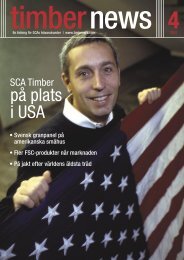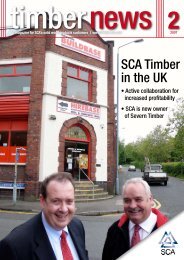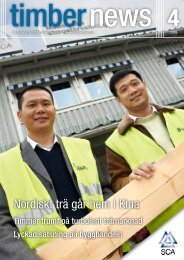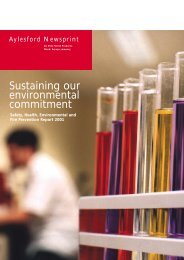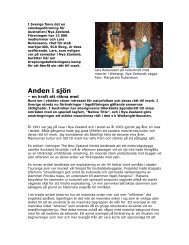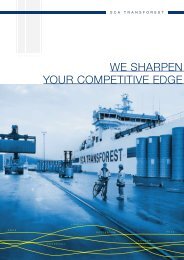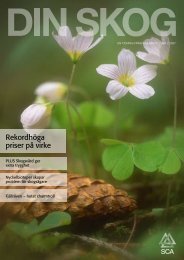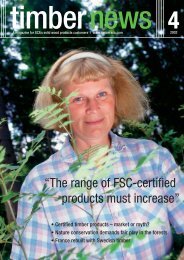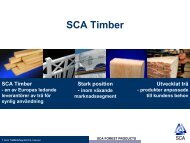timber news 3/2009 - SCA Forest Products AB
timber news 3/2009 - SCA Forest Products AB
timber news 3/2009 - SCA Forest Products AB
- No tags were found...
Create successful ePaper yourself
Turn your PDF publications into a flip-book with our unique Google optimized e-Paper software.
Two for the price of one:Cutting costs and CO 2The link between cutting CO 2 emissions and cuttingbusiness costs was the focus of <strong>SCA</strong> Timber’sJune conference on ‘<strong>Forest</strong>s, Wood Supply and theLow Carbon Economy’.To mark the 10 th anniversaryof its FSC forest managementcertification, <strong>SCA</strong> TimberSupply’s special conference onCO 2 and cost reduction in Junebrought together business acrossthe wood supply chain, from procurementand sustainability managersto suppliers – builders’ and<strong>timber</strong> merchants and wood productmanufacturers.Conference delegate David Berryis managing director of independentbuilders’ merchants C&WBerry Ltd and <strong>timber</strong> chairman ofmerchant buying group CEMCO.“As individuals we have our ownpersonal concerns about climatechange. At business level we arealso aware of the government’sinterest in carbon reduction andare monitoring it closely,” he commented.”When tendering forbusiness, pre-qualification questionnairesnow demand that companiesare able to tick certainboxes such as <strong>timber</strong> certificationand waste management. As carbonbecomes a matter of competitiveadvantage, so companies will makethe changes necessary to continuewinning business.”The conference heard that thecarbon footprint of one cubicmetre of wood products from<strong>SCA</strong>, from tree nursery to despatchquayside in Sweden, is 33kg CO 2– roughly the footprint of onefamily-sized roast beef joint forSunday lunch, or to using 14 litresof diesel. Compared to other constructionmaterials, this equates toslightly more than five per cent ofthe emissions from the productionof a corresponding weight of aluminiumand far less than five percent of the emissions from thesame weight of PVC.The growth of one cubic metreof wood in <strong>SCA</strong>’s forests innorthern Sweden sequesters 1.3tonnes of carbon dioxide from theatmosphere. Since the growth in<strong>SCA</strong>’s forest is 25 per cent higherthan felling, a net total of 250 kgof carbon dioxide is sequesteredfor every cubic metre of sawn<strong>timber</strong> produced. Additional climatebenefits derive from <strong>SCA</strong> utilisingits production sawdust asbiofuel.<strong>SCA</strong> uses the sawdust from producinga cubic metre of sawn<strong>timber</strong> to make biofuel pellets forenergy. To put the additional benefitsinto perspective, if substitutingoil-based energy for this smallamount of pellets , the CO 2 emissionsfrom the oil would amountto more than the emissions from<strong>SCA</strong>’s production and transport ofthe cubic metre of sawn <strong>timber</strong>delivered to <strong>SCA</strong> Timber Supply inthe UK.CEMCO’s Timber group chairman David Berry of C & W Berry (right) talks with Rob Simpson of <strong>SCA</strong>.Many organisations in Britainthat fall beyond the scope of EUemissions trading are now subjectto a new cap and trade scheme:the Carbon Reduction Commitment.It affects <strong>SCA</strong>’s larger UKwood customers, many of whomwere amongst the conferenceaudience. From national builders’merchant chain Travis Perkins plc,Environmental Manager JezCutler was interested in the presentationof <strong>SCA</strong>’s carbon factsand figures: “Travis Perkins anticipatesthat customers will soon beasking for detailed information oncarbon footprint. We will in turnbe asking our suppliers for theirdata. It is good to see <strong>SCA</strong> bravelycontributing to the debate, andcoming forward with well-foundedinformation.”<strong>timber</strong><strong>news</strong> | 4



